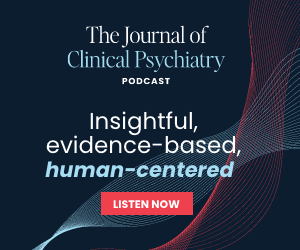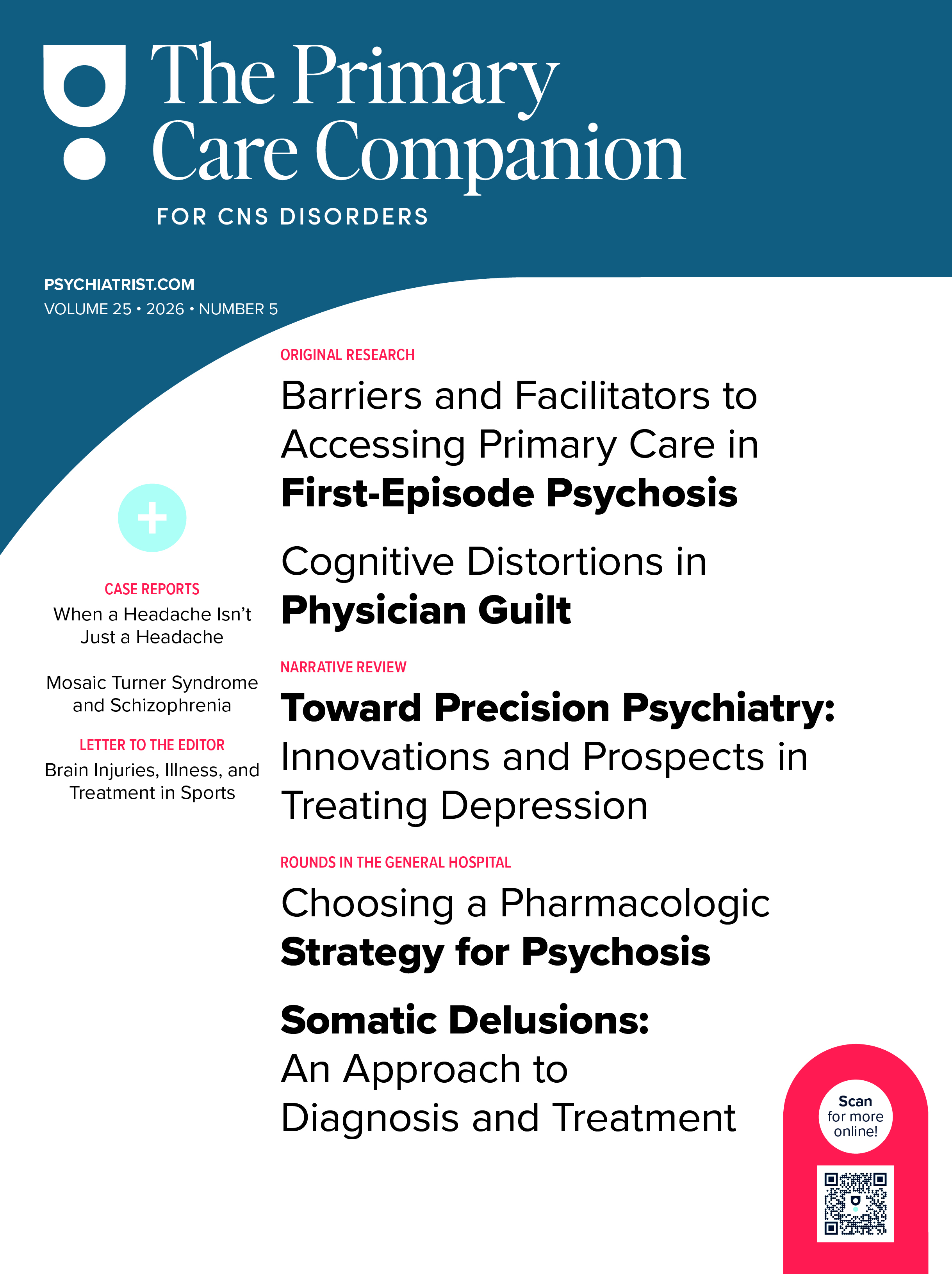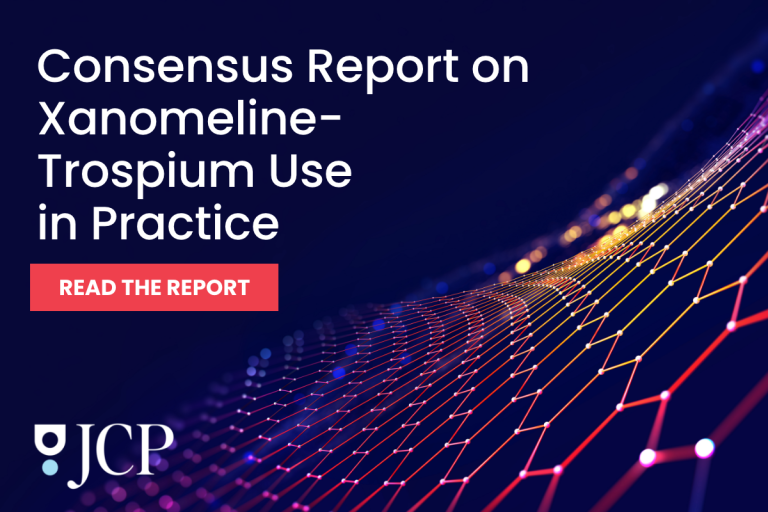Lessons Learned at the Interface of Medicine and Psychiatry
The Psychiatric Consultation Service at Massachusetts General Hospital sees medical and surgical inpatients with comorbid psychiatric symptoms and conditions. During their twice-weekly rounds, Dr Stern and other members of the Consultation Service discuss diagnosis and management of hospitalized patients with complex medical or surgical problems who also demonstrate psychiatric symptoms or conditions. These discussions have given rise to rounds reports that will prove useful for clinicians practicing at the interface of medicine and psychiatry.
Prim Care Companion CNS Disord 2025;27(5):25f03997
Author affiliations are listed at the end of this article.
Have you ever wondered how far blood pressure (BP) must drop, and for how long, before one’s mental status becomes impaired? Have you been unsure of how hypotension interrupts the brain’s normal functioning? Have you considered that synergistic effects (eg, of anemia, hypoxemia, metabolic disarray, and altered neurotransmitter levels) might coalesce and contribute to an altered mental status? Have you wondered which brain territories are most sensitive to hypotension and how that interferes with affect, behavior, cognition, and motor function? If you have, the following case vignette and discussion should prove useful.
CASE VIGNETTE
Mr A, a 70-year-old fisherman with type 2 diabetes mellitus, hypertension, and a history of an inferior wall myocardial infarction and a stroke, was admitted to the intensive care unit (ICU) with a severe pneumonia. He was febrile (temperature: 102.6° F), tachycardic (heart rate: 110 beats/minute), and hypotensive (BP: 100/60 mm Hg) and had labored breathing; his medical team was concerned that he was septic. Fortunately, his electrocardiogram failed to show evidence of a new cardiac event, and his QTc was normal.
On examination, Mr A was fluent, initiated little speech, and kept his responses (which were barely audible, but salty) brief. In addition, he was inattentive, irritable, and disoriented to time and place (thinking he was aboard his ship). Neither hallucinations nor delusions were apparent. Intravenous (IV) fluids, antipyretics, and antibiotics were started, and he was given low doses (2 mg IV) of haloperidol to mitigate his irritability, agitation, and disorientation.
DISCUSSION
What Is Meant by Relative and Absolute Hypotension?
Absolute hypotension reflects a BP of less than 90 mm Hg or a mean arterial pressure (MAP) of less than 65 mm Hg. Relative hypotension refers to a decrease in BP when compared to a person’s baseline BP,1 and it often goes underdiagnosed and undertreated in ICUs. Patients with a history of hypertension and who drop their BP to a MAP of 65 mm Hg are at risk for organ hypoperfusion (and its sequelae), despite achieving a target goal BP.2
What Does the Brain Require to Avoid Disturbances of Affect, Behavior, and Cognition?
The human brain requires constant, precisely regulated support to maintain well-functioning affect, behavior, and cognition.3 Disturbances in any of its fundamental resources interfere with brain homeostasis, which rapidly leads to neurological and psychiatric dysfunction. Adequate blood flow is necessary to deliver oxygen and glucose while removing metabolic waste products.4,5 Cerebral hypoperfusion triggers localized or diffuse brain dysfunction (eg, manifest by distractibility, impaired attention, emotional lability, impulsivity, memory impairment, and hyperactivity or hypoactivity). Acute and chronic disruptions in perfusion can lead to irreversible neuronal injury.
Glucose serves as the brain’s primary energy source under normal physiologic conditions.3 Unfortunately, neurons have limited glycogen reserves, and they are highly sensitive to fluctuations in glucose supply. Lack of glucose impairs neuronal firing and synaptic communication, which leads to symptoms (eg, irritability, impaired judgment, memory lapses, and, in severe cases, seizures and coma).6
Oxygen is essential for aerobic metabolism in neurons, primarily to produce adenosine triphosphate (ATP) via oxidative phosphorylation.5 ATP is required to maintain ion gradients, neurotransmitter synthesis, and signal transduction. Even brief periods of hypoxia can disrupt membrane potentials, impair synaptic transmission, and precipitate behavioral disturbances (eg, agitation) and loss of consciousness.7
The maintenance of proper levels of electrolytes, including sodium, potassium, calcium, and magnesium, is critical for neuronal excitability and synaptic transmission.8,9 Disturbances in electrolyte levels can lead to abnormal neuronal firing, which can result in emotional lability, “brain fog,” restlessness, and seizure activity.
The synthesis, release, and recycling of neurotransmitters (including dopamine, serotonin, glutamate, γ-aminobutyric acid [GABA], and acetylcholine) are central to mood regulation, cognitive processing, and motor control,10 and imbalances in neurotransmitter systems are associated with neuropsychiatric and psychiatric disorders.11–14
Efficient clearance of metabolic waste and neurotoxic substances through the glymphatic system and blood-brain barrier is vital.15 Impaired waste clearance contributes to the accumulation of β-amyloid and other toxic proteins, which are implicated in cognitive decline and neurodegenerative diseases.
The presence of inflammatory cytokines, reactive oxygen species (ROS), and systemic or central neurotoxins can disrupt neuronal function and integrity.16 Neuroinflammation is increasingly recognized as a key factor in the pathogenesis of mood disorders (eg, depression),17 delirium,18 and neurocognitive disorders.19 Therefore, brain functioning requires the continuous and balanced supply of oxygen, glucose, electrolytes, cerebral blood flow, neurotransmitters, and efficient waste clearance, as well as protection from inflammatory and toxic insults.
How Long Can the Brain Continue to Function Appropriately If the Neuroanatomical Structures and Pathways and Neurotransmitter Systems Become Disrupted?
Disruption or deprivation of glucose, oxygen, neurotransmitters, and ions can rapidly (within minutes) compromise the neuropsychiatric functions (eg, cognition) that depend on a complex homeostasis. Moreover, a decrease in ATP levels, followed by failure of ion pumps, loss of membrane potential, and inappropriate neurotransmitter release, damages cellular structures and leads to neuronal death. In the first 1–2 minutes, hypoxia and hypoglycemia induce the cessation of oxidative phosphorylation, which causes a sharp decline in ATP levels.2,4 Without adequate levels of ATP, ion pumps fail, resulting in neuronal depolarization. In 3–5 minutes, a loss of membrane potentials leads to an influx of calcium ions into neurons, thereby triggering excitotoxic release of glutamate.5,7 In 5–10 minutes, persistent energy failure and excitotoxicity induce mitochondrial dysfunction, generation of ROS, and activation of apoptotic pathways.4 These changes coincide with loss of consciousness and irreversible neuronal injury. Beyond 10 minutes, widespread neuronal death begins, especially in vulnerable areas (eg, the hippocampus and cerebral cortex). Long-term outcomes (eg, severe cognitive impairment, dementia, emotional dysregulation, and coma) develop if perfusion is not restored.5
When toxins (eg, ammonia or β-amyloid peptides) accumulate, neuronal cell function and blood-brain barrier integrity become disrupted, neurotransmitter imbalances cause excitotoxicity, and toxins trigger neuroinflammation, which leads to cell death.20,21 Initial responses include oxidative stress and microglial activation. Early behavioral changes often include confusion and irritability. Generation of ROS further damages DNA, proteins, and lipids. Beyond 10 minutes, toxin exposure results in apoptotic and necrotic cell death, synaptic loss, and progression toward neurodegenerative diseases (eg, Alzheimer disease).15,22 Clinically, this may manifest as memory impairment, cognitive decline, delirium, or persistent affective disturbances (eg, depression).
How Low Must BP Be, and How Long, Before Mental Status Becomes Impaired?
The brain, via cerebral autoregulation, attempts to maintain perfusion and function despite systemic BP fluctuations; however, this process has limits. For most healthy individuals, cerebral perfusion declines steeply when the MAP falls below 50 mm Hg.23 When brain perfusion is severely reduced, unconsciousness typically develops in 6–8 seconds,24 and permanent neurological damage often occurs when this state persists beyond several minutes. However, even brief episodes during which the MAP drops below 50 mm Hg have been associated with the development of delirium among critically ill patients.23 Failure to perfuse the brain can also result from relative hypotension (as is frequently seen in elderly individuals with a history of hypertension whose BP falls to relatively “normal” BP levels). Therefore, most intensivists attempt to keep their patients’ MAPs greater than 65 mm Hg (using vasopressors when necessary) to mitigate end organ dysfunction that results from lower BPs. Diastolic pressures below 60 mm Hg are also a matter of concern, given their disproportionate importance for the perfusion of organs with low-flow resistance (eg, the brain).25 One study of intraoperative hypotension found that individuals with a MAP below 65 mm Hg for 5 minutes or longer had higher rates of postoperative delirium,26 and a study of ICU patients admitted for shock found an association between the number of hypotensive episodes and the development of delirium.23 Long-term cognitive dysfunction has also been associated with hypotension; a study linked the lowest measured MAP and worse cognitive outcomes at 1-year follow up.27
In addition, chronic hypotension may contribute to impairment in affect, behavior, and cognition, even in those who are not acutely ill or overtly symptomatic.28,29 Therefore, the relationship between BP and mental status is best understood as dose- and time-dependent: large drops in BP induce mental status abnormalities within seconds, while more modest decreases in BP lead to changes over minutes, hours, or even years.
Which Brain Territories Are Most Sensitive to Hypotension, and How Does Hypotension Interfere With Affect, Behavior, Cognition, and Motor Function?
The sensitivity of specific brain territories to hypotension depends largely on the balance of the vulnerability to reduced perfusion pressures and the structures’ metabolic requirements. For example, in watershed areas (ie, border zones among cerebral vascular territories), the tissue farthest from arterial blood flow is most vulnerable to decreases in perfusion pressure.30 Infarction in the area perfused at the border of anterior and middle cerebral artery flow is manifest by specific cognitive deficits, including Balint syndrome (with oculomotor apraxia, optic ataxia, and simultaneous agnosia), Gerstmann syndrome (with acalculia, agraphia, finger agnosia, and left/right disorientation), and transcortical aphasia. Infarction in the border zone between the flow of the middle and posterior cerebral arteries produces proximal weakness in the upper limbs, known as “man in the barrel syndrome.”31 Watershed infarcts also occur in deep brain structures and the cerebellum, although their clinical manifestations are not specific. Infarction of these areas may result from hypotension; however, comorbid embolic events and arterial stenosis are often contributory.30
The metabolic demands of various brain regions further influence their susceptibility to hypotension. The hippocampus, specifically the pyramidal cells of the CA1 region, is especially sensitive to hypotension due to its high metabolic requirements and abundance of excitatory glutamatergic neurons.32 Moreover, although the hippocampus exhibits functional lateralization (with the right crucial for spatial memory and the left focused on verbal and narrative memory), hypotension often involves both effects. The pyramidal cells of the cerebral cortex and the Purkinje cells of the cerebellum are similarly vulnerable.32 Given the shared vulnerability of these broadly distributed structures, disruptions in executive function (eg, attention, sequencing, planning), sleep, and behavior (eg, with impulsivity or apathy) frequently occur and often last for weeks or months after hypotensive events.33
Processes that require a high level of functional integration and coordination across brain regions are also prone to disruption. Consequently, delirium frequently arises after even brief hypotensive episodes.23,34 Prolonged subacute hypotension may also contribute to the development of neurocognitive disorders,23,35 although causality remains unclear. Chronic hypotension has also been associated with depression and anxiety, perhaps mediated by autonomic nervous system dysregulation.36 While the brain stem is relatively resistant to hypotension, its disruption has rapid and catastrophic effects. For instance, when the reticular activating system (which is comprised by a bundle of neurons that project from several midbrain nuclei to the hypothalamus and thalamus) is disrupted, arousal, muscle tone, and autonomic function can fail rapidly.37
How Can Synergistic Effects Coalesce and Contribute to an Altered Mental Status?
Hypotension (and reduced perfusion) interacts to impair mental status by compounding problems with gas exchange (primarily oxygen delivery), neurovascular dynamics, neuronal metabolism, and neurotoxicity. Therefore, patients who present after trauma or cardiovascular events demonstrate significantly worse neurological outcomes when hypotension coexists with hypoxia or anemia,38 and this synergistic effect is even more pronounced when a traumatic brain injury disrupts neurovascular patency.39,40
Cerebral perfusion serves to clear carbon dioxide, but hypocapnia appears to worsen outcomes in hypotensive patients, perhaps by inducing cerebral vasoconstriction and neuronal excitability.41,42 Oxygen and carbon dioxide levels also modulate sympathetic tone and thus systemic BP, which further complicates the clinical picture.
Systemic metabolic derangements also modulate the relationship between hypotension and mental status. Hyperglycemia and hypoglycemia can each exacerbate neuronal metabolic failures and cause fluid shifts that further disrupt perfusion.43,44 Liver failure produces multiple effects, making fluid shifts and hypotension more likely, increasing the risk of bleeding and anemia, and disrupting the blood brain barrier and cerebrovascular coupling via hyperammonemia.45 Similarly, individuals with hemodialysis-dependent renal failure are at risk for delirium and hypotension and have a higher risk of uremia and electrolyte disturbances, which can compound the effects of hypotension on neurocognitive function.46
Neurotransmitter levels also affect the brain’s capacity to autoregulate during systemic hypotension. Central control of systemic BP is managed by GABAergic and glutamatergic circuits, and during periods of shock, the body attempts to compensate by increasing sympathetic tone.47 These reactions are characterized by increased catecholamine release and abnormal release of GABA, glutamate, and serotonin, with subsequent neurotransmitter depletion and impaired synthesis.48 Pharmacologic modulation of neurotransmission can also impair the brain’s ability to compensate during hypotension. Benzodiazepines, antidepressants, antipsychotics, opiates, and anticholinergic agents can contribute to orthostatic hypotension.49,50 The brain has exquisite mechanisms to regulate systemic and local perfusion during hypotension, but when comorbid factors disrupt these controls, the resulting decompensation can be unpredictably severe and difficult to treat.51,52
How Important Is It to Contextualize and Interpret a BP Reading at a Point in Time?
BP readings should always be interpreted in the context of individual patient factors. For example, a BP of 100/60 mm Hg in a young, healthy woman differs in its significance from the same BP in a 78-year-old man with a history of hypertension and a cerebrovascular accident. While hypotension often leads to diminished organ perfusion, perfusion is determined by the perfusion pressure divided by the regional vascular resistance (RVR), which, according to Poiseuille law, is determined by vascular length, vascular radius, and blood viscosity. Certain factors (eg, age, BP, atherosclerosis, hypercapnia, administration of vasoactive drugs) can lead to alterations in RVR. If alterations in perfusion pressure and an organ’s RVR co-occur, organ perfusion remains relatively stable. If a decrease in perfusion pressure is less than the change of the RVR, organ perfusion increases. If the perfusion pressure is reduced, but the RVR remains the same, increases, or decreases to a lesser degree when compared to the perfusion pressure, organ perfusion decreases. Therefore, a 78-year-old man with a history of hypertension and a stroke would be prone to have a higher vascular resistance secondary to his age, BP, and suspected atherosclerosis (given his stroke history). Unless his perfusion pressure can compensate for an increased RVR, organ perfusion will be reduced.53
Unfortunately, many models of risk stratification apply BP cutoffs that are independent of age. Certain populations are at greater risk for drops in perfusion pressure; older adults with a decrease in BP show an increased mortality rate that is associated with changing vital signs.54 Furthermore, widely accepted criteria for defining hypotension in ICUs have not been established formally.53 A decrease in systolic BP that exceeds 7 mm Hg confers an increased mortality risk, with some data indicating that relative hypotension may lead to an increased risk of mortality.55
What Are the Acute and Long-Term Sequelae of Having Had Episodes of Hypotension or Shock?
Among critically ill individuals, deficits in BP are associated with progressive organ dysfunction. When organs are inadequately perfused, the metabolic demands of tissues cannot be met. Acutely, this leads to inadequate aerobic metabolism, along with cell and tissue injury and death. If organs continue to be inadequately perfused, organ failure results.56
Shock, an acute and potentially life-threatening condition, involves inadequate perfusion to organ systems and multiorgan failure. Shock can be distributive, cardiogenic, hypovolemic, obstructive, hypotensive, or combined based on its etiology. Shock’s sequelae range involves short-term and long-term manifestations (eg, physical, behavioral, and emotional).1
Hemorrhagic shock, a form of hypovolemic shock, develops due to severe blood loss and inadequate oxygen delivery at the cellular level.57 When aerobic metabolism is switched to anaerobic metabolism, lactic acid, oxygen radicals, and inorganic phosphates accumulate. Damage-associated molecular patterns are released that incite a systemic inflammatory response. ATP supplies diminish causing a failure of cellular homeostasis and cell death through membrane rupture, necroptosis, or apoptosis. Vasoconstriction and hypovolemia adversely affect the liver, intestines, kidneys, and skeletal muscles.58–61
Organ involvement in shock is predictable; first, it affects the lungs (eg, with adult respiratory distress syndrome), then the liver and gut. Pulmonary dysfunction is revealed by decreased compliance, impaired gas exchange, and shunting of blood through unventilated areas. Affected individuals are initially mildly hypoxemic and have respiratory alkalosis. As pulmonary function deteriorates, mechanical ventilation becomes essential to maintain oxygenation and to remove carbon dioxide.60
The liver is often the second organ to become impaired with shock, with deficits seen in synthesis, immunologic function, and detoxification. Afflicted patients frequently present with jaundice, secondary to poor biliary excretion, and an altered mental status from hepatic encephalopathy.60
Manifestations of renal injury are often seen 7–10 days after the onset of hypotension, and impairments are revealed through a reduction in renal concentrating ability and excretion. Reduced glomerular perfusion results in low urine output, an inability to eliminate waste water, subsequent edema, systemic hypervolemia, and electrolyte abnormalities (eg, hyperkalemia) that interfere with cardiac function.Individuals may require dialysis when the renal injury is severe.60
Following renal involvement, the intestines are often affected. The epithelial barrier of intestinal mucosa is often disrupted, leading to bacterial translocation and an increased risk for infections. Hemorrhagic stress erodes the stomach, induces malabsorption, and causes ileus, pancreatitis, and acalculous cholecystitis.
Hematologic and immunologic manifestations (eg, leukocytosis, neutropenia, thrombocytopenia) increase the risks of ICU-acquired infections. The clotting cascade is often activated; this leads to disseminated intravascular coagulation, thrombosis, and depletion of procoagulant blood factors resulting in hypocoagulopathy and uncontrolled bleeding.60
Cardiac functioning may also be involved, manifesting as supraventricular arrhythmias and impaired myocardial contractility.60 In survivors of shock, central nervous system involvement leads to roughly 1 in 5 individuals having symptoms of depression with two-fifths having symptoms of anxiety.61
WHAT HAPPENED TO MR A?
By the following morning, Mr A’s vital signs were returning to normal; he was afebrile and oxygenating better, and his heart rate had decreased to 88 beats/ minute, while his BP had risen to 132/84 mm Hg. He was exhausted, but more attentive, and he was relieved that he was breathing more comfortably. His medical team was relieved by his progress and encouraged by his improved oxygenation and perfusion that had combined to alter his mental status.
CONCLUSION
Cerebral hypoperfusion triggers localized or diffuse brain dysfunction (eg, manifest by emotional lability, impulsivity, and memory impairment). In the first 1–2 minutes of hypoperfusion, hypoxia and hypoglycemia induce the cessation of oxidative phosphorylation, which causes a sharp decline in ATP levels. In 3–5 minutes, a loss of membrane potentials leads to an influx of calcium ions into neurons, thereby triggering excitotoxic release of glutamate. Excessive stimulation of N-methyl-D-aspartate receptors then exacerbates intracellular calcium overload, which activates proteases, lipases, and endonucleases that damage cellular structures. In 5–10 minutes, persistent energy failure and excitotoxicity induce mitochondrial dysfunction, generation of ROS, and activation of apoptotic pathways.
Hypotension acts synergistically to affect mental status by compounding problems with gas exchange, neurovascular dynamics, neuronal metabolism, and neurotoxicity. Moreover, BP readings should always be interpreted in the context of individual patient factors.
Article Information
Published Online: October 23, 2025. https://doi.org/10.4088/PCC.25f03997
© 2025 Physicians Postgraduate Press, Inc.
Submitted: May 5, 2025; accepted July 7, 2025.
To Cite: Braford MB, Li J, Hoover BJ, et al. The impact of relative and absolute hypotension on cognitive function. Prim Care Companion CNS Disord 2025;27(5): 25f03997.
Author Affiliations: Lewis Gale Medical Center, Salem, Virginia (Braford), Nova Southeastern University, Orlando, Florida (Li), Stanford University, Stanford, California (Hoover), and Massachusetts General Hospital/Harvard Medical School, Boston, Massachusetts (Stern).
Braford, Li, and Hoover are co-first authors; Stern is senior author.
Corresponding Author: Theodore A. Stern, MD, Massachusetts General Hospital, 55 Fruit Street, WRN 606, Boston, MA 02114 ([email protected]).
Relevant Financial Relationships: Dr Stern had received royalties from Elsevier for editing textbooks on psychiatry. Drs Braford, Li, and Hoover report no relevant financial relationships.
Funding/Support: None.
Clinical Points
- Brain function requires the continuous and balanced supply of oxygen, glucose, electrolytes, cerebral blood flow, neurotransmitters, and efficient waste clearance, as well as protection from inflammatory and toxic insults.
- For most healthy individuals, cerebral perfusion declines steeply when the mean arterial pressure (MAP) falls below 50 mm Hg; when brain perfusion is severely reduced, unconsciousness typically develops in 6–8 seconds, and permanent neurological damage often occurs when this state persists beyond several minutes.
- Absolute hypotension reflects a blood pressure (BP) of less than 90 mm Hg or a MAP of less than 65 mm Hg; relative hypotension refers to a decrease in BP when compared to a person’s baseline BP.
References (61)

- Sharma S, Hashmi MF, Bhattacharya PT. Hypotension. [Updated 2023 Feb 19]. In: StatPearls [Internet]. StatPearls Publishing; 2025. https://www.ncbi.nlm.nih.gov/sites/books/NBK499961/
- Panwar R, Tarvade S, Lanyon N, et al. Relative hypotension and adverse kidney-related outcomes among critically ill patients with shock. A multicenter, prospective cohort study. Am J Respir Crit Care Med. 2020;202(10):1407–1418. PubMed CrossRef
- Mergenthaler P, Lindauer U, Dienel GA, et al. Sugar for the brain: the role of glucose in physiological and pathological brain function. Trends Neurosci. 2013;36(10):587–597. PubMed CrossRef
- Radak Z, Zhao Z, Koltai E, et al. Oxygen consumption and usage during physical exercise: the balance between oxidative stress and ROS-dependent adaptive signaling. Antioxid Redox Signal. 2013;18(10):1208–1246. PubMed CrossRef
- Dirnagl U, Iadecola C, Moskowitz MA. Pathobiology of ischaemic stroke: an integrated view. Trends Neurosci. 1999;22(9):391–397. PubMed CrossRef
- Lipton P. Ischemic cell death in brain neurons. Physiol Rev. 1999;79(4):1431–1568. PubMed CrossRef
- Lo EH, Dalkara T, Moskowitz MA. Mechanisms, challenges and opportunities in stroke. Nat Rev Neurosci. 2003;4(5):399–415. PubMed CrossRef
- Pchitskaya E, Popugaeva E, Bezprozvanny I. Calcium signaling and molecular mechanisms underlying neurodegenerative diseases. Cell Calcium. 2018;70:87–94. PubMed CrossRef
- Benveniste H, Drejer J, Schousboe A, et al. Elevation of the extracellular concentrations of glutamate and aspartate in rat hippocampus during transient cerebral ischemia monitored by intracerebral microdialysis. J Neurochem. 1984;43(5):1369–1374. PubMed CrossRef
- Teleanu RI, Niculescu AG, Roza E, et al. Neurotransmitters-key factors in neurological and neurodegenerative disorders of the central nervous system. Int J Mol Sci. 2022;23(11):5954. PubMed CrossRef
- Nedic Erjavec G, Sagud M, Nikolac Perkovic M, et al. Depression: biological markers and treatment. Prog Neuropsychopharmacol Biol Psychiatry. 2021;105:110139. PubMed CrossRef
- Cai Y, Xing L, Yang T, et al. The neurodevelopmental role of dopaminergic signaling in neurological disorders. Neurosci Let. 2021;741:135540. PubMed CrossRef
- Iovino L, Tremblay ME, Civiero L. Glutamate-induced excitotoxicity in Parkinson’s disease: the role of glial cells. J Pharmacol Sci. 2020;144(3):151–164. PubMed CrossRef
- Ju Y, Tam KY. Pathological mechanisms and therapeutic strategies for Alzheimer’s disease. Neural Regen Res. 2022;17(3):543–549. PubMed CrossRef
- Wyss-Coray T, Mucke L. Inflammation in neurodegenerative disease—a double-edged sword. Neuron. 2002;35(3):419–432. PubMed CrossRef
- DiSabato DJ, Quan N, Godbout JP. Neuroinflammation: the devil is in the details. J Neurochem. 2016;139(Suppl 2):136–153. PubMed CrossRef
- Najjar S, Pearlman DM, Alper K, et al. Neuroinflammation and psychiatric illness. J Neuroinflamm. 2013;10:1–24. CrossRef
- Xiao MZ, Liu CX, Zhou LG, et al. Postoperative delirium, neuroinflammation, and influencing factors of postoperative delirium: a review. Medicine. 2023;102(8):e32991. PubMed CrossRef
- Heneka MT, Carson MJ, El Khoury J, et al. Neuroinflammation in Alzheimer’s disease. Lancet Neurol. 2015;14(4):388–405. PubMed CrossRef
- Butterworth RF. Altered glial-neuronal crosstalk: cornerstone in the pathogenesis of hepatic encephalopathy. Neurochem Int. 2010;57(4):383–388. PubMed CrossRef
- Bosoi CR, Rose CF. Identifying the direct effects of ammonia on the brain. Metab Brain Dis. 2009;24(1):95–102. PubMed CrossRef
- Kempuraj D, Thangavel R, Natteru PA, et al. Neuroinflammation induces neurodegeneration. J Neurol Neurosurg Spine. 2016;1(1):1003. PubMed
- Nguyen DN, Huyghens L, Parra J, et al. Hypotension and a positive fluid balance are associated with delirium in patients with shock. PloS One. 2018;13(8):e0200495. PubMed CrossRef
- van Dijk JG, van Rossum IA, Thijs RD. Timing of circulatory and neurological events in syncope. Front Cardiovasc Med. 2020;7:36. PubMed CrossRef
- Schuurmans J, van Rossem BTB, Rellum SR, et al. Hypotension during intensive care stay and mortality and morbidity: a systematic review and meta-analysis. Intensive Care Med. 2024;50(4):516–525. PubMed CrossRef
- Duan W, Zhou CM, Yang JJ, et al. A long duration of intraoperative hypotension is associated with postoperative delirium occurrence following thoracic and orthopedic surgery in elderly. J Clin Anesth. 2023;88:111125. PubMed CrossRef
- Laurikkala J, Wilkman E, Pettilä V, et al. Mean arterial pressure and vasopressor load after out-of-hospital cardiac arrest: associations with one-year neurologic outcome. Resuscitation. 2016;105:116–122. PubMed CrossRef
- Cheng Y, Lin L, Huang P, et al. Hypotension with neurovascular changes and cognitive dysfunction: an epidemiological, pathobiological, and treatment review. Chin Med J. 2025;138(4):405–418. PubMed CrossRef
- Skoog I, Lernfelt B, Landahl S, et al. 15-year longitudinal study of blood pressure and dementia. Lancet. 1996;347(9009):1141–1145. PubMed CrossRef
- Sorgun MH, Rzayev S, Yilmaz V, et al. Etiologic subtypes of watershed infarcts. J Stroke Cerebrovasc Dis. 2015;24(11):2478–2483. PubMed CrossRef
- Dogariu OA, Dogariu I, Vasile CM, et al. Diagnosis and treatment of watershed strokes: a narrative review. J Med Life. 2023;16(6):842–850. PubMed CrossRef
- Fugate JE. Anoxic-ischemic brain injury. Neurol Clin. 2017;35(4):601–611. PubMed CrossRef
- Feng X, Hu J, Hua F, et al. The correlation of intraoperative hypotension and postoperative cognitive impairment: a meta-analysis of randomized controlled trials. BMC Anesthesiol. 2020;20(1):193. PubMed CrossRef
- Maldonado JR. Delirium pathophysiology: an updated hypothesis of the etiology of acute brain failure. Int J Geriatr Psychiatry. 2018;33(11):1428–1457. PubMed CrossRef
- Xia X, Qiu C, Rizzuto D, et al. Role of orthostatic hypotension in the development of dementia in people with and without cardiovascular disease. Hypertension. 2023;80(7):1474–1483. PubMed CrossRef
- Duschek S, Hoffmann A, Reyes del Paso GA. Affective impairment in chronic low blood pressure. J Psychosom Res. 2017;93:33–40. PubMed CrossRef
- Zurak N, Bilic E. Syncope: facts and fiction. Med Hypotheses. 2004;63(3):394–401. PubMed CrossRef
- Wormsbecker A, Sekhon MS, Griesdale DE, et al. The association between anemia and neurological outcome in hypoxic ischemic brain injury after cardiac arrest. Resuscitation. 2017;112:11–16. PubMed CrossRef
- Kim MW, Shin SD, Song KJ, et al. Interactive effect between on-scene hypoxia and hypotension on hospital mortality and disability in severe trauma. Prehosp Emerg Care. 2018;22(4):485–496. PubMed CrossRef
- Hirunpattarasilp C, Shiina H, Na-Ek N, et al. The effect of hyperoxemia on neurological outcomes of adult patients: a systematic review and meta-analysis. Neurocrit Care. 2022;36(3):1027–1043. PubMed CrossRef
- Ringer SK, Ohlerth S, Carrera I, et al. Effects of hypotension and/or hypocapnia during sevoflurane anesthesia on perfusion and metabolites in the developing brain of piglets—a blinded randomized study. Pediatr Anesth. 2016;26(9):909–918. PubMed CrossRef
- Qiu X, Zhang Y, Wang Q, et al. Effect of hypercapnia on neurologic outcomes after cardiac arrest: a systematic review and meta-analysis. Am J Emerg Med. 2025;89:5–11. PubMed CrossRef
- Cruz-Flores S. Neurological complications of endocrine emergencies. Curr Neurol Neurosci Rep. 2021;21(5):21. PubMed CrossRef
- Grelli KN, Gindville MC, Walker CH, et al. Association of blood pressure, blood glucose, and temperature with neurological outcome after childhood stroke. JAMA Neurol. 2016;73(7):829–835. PubMed CrossRef
- L’Écuyer S, Charbonney E, Carrier FM, et al. Implication of hypotension in the pathogenesis of cognitive impairment and brain injury in chronic liver disease. Neurochem Res. 2024;49(6):1437–1449. PubMed
- Arnold R, Issar T, Krishnan AV, et al. Neurological complications in chronic kidney disease. JRSM Cardiovasc Dis. 2016;5:2048004016677687. PubMed CrossRef
- Dupont AG, Légat L. GABA is a mediator of brain AT1 and AT2 receptor-mediated blood pressure responses. Hypertens Res. 2020;43(10):995–1005. PubMed CrossRef
- Atterton B, Paulino MC, Povoa P, et al. Sepsis associated delirium. Medicina (Kaunas). 2020;56(5):240. PubMed CrossRef
- Rivasi G, Kenny RA, Ungar A, et al. Effects of benzodiazepines on orthostatic blood pressure in older people. Eur J Intern Med. 2020;72:73–78. PubMed CrossRef
- Ilkin Naharci M. Frail older adults with high anticholinergic burden are at risk of orthostatic hypotension. J Am Med Dir Assoc. 2025;26(3):105436. PubMed CrossRef
- Attwell D, Buchan AM, Charpak S, et al. Glial and neuronal control of brain blood flow. Nature. 2010;468(7321):232–243. PubMed CrossRef
- Natsubori A, Kwon S, Honda Y, et al. Serotonergic regulation of cortical neurovascular coupling and hemodynamics upon awakening from sleep in mice. J Cereb Blood Flow Metab. 2024;44(9):1591–1607. PubMed CrossRef
- Meng L. Heterogeneous impact of hypotension on organ perfusion and outcomes: a narrative review. Br J Anaesth. 2021;127(6):845–861. PubMed CrossRef
- Candel BG, Duijzer R, Gaakeer MI, et al. The association between vital signs and clinical outcomes in emergency department patients of different age categories. Emerg Med J. 2022;39(12):903–911. PubMed CrossRef
- van Oppen JD, Owen RK, Jones W, et al. The effect of relative hypotension on 30-day mortality in older people receiving emergency care. Intern Emerg Med. 2024;19(3):787–795. PubMed CrossRef
- Harjola VP, Mullens W, Banaszewski M, et al. Organ dysfunction, injury and failure in acute heart failure: from pathophysiology to diagnosis and management. A review on behalf of the Acute Heart Failure Committee of the Heart Failure Association (HFA) of the European Society of Cardiology (ESC). Eur J Heart Fail. 2017;19(7):821–836. PubMed CrossRef
- Cannon JW. Hemorrhagic shock. N Engl J Med. 2018;378(4):370–379. PubMed CrossRef
- Eastridge BJ, Holcomb JB, Shackelford S. Outcomes of traumatic hemorrhagic shock and the epidemiology of preventable death from injury. Transfusion. 2019;59(S2):1423–1428. PubMed CrossRef
- Faria I, Thivalapill N, Makin J, et al. Bleeding, hemorrhagic shock, and the global blood supply. Crit Care Clin. 2022;38(4):775–793. PubMed CrossRef
- Armstrong D.. Free Radicals in Diagnostic Medicine: A Systems Approach to Laboratory Technology, Clinical Correlations, and Antioxidant Therapy. Springer Science and Business Media; 2012.
- Pratt CM, Hirshberg EL, Jones JP, et al. Long-term outcomes after severe shock. Shock. 2015;43(2):128–132. PubMed CrossRef
Please sign in or purchase this PDF for $40.





